
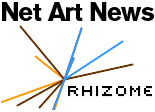 |
| | wattenberg | levin 1 | levin 2 | kanarinka | murthy | crawford | arcangel | horvath 1 | salvaggio | clauss | swipe | magruder | sodeoka 1 | ludin | horvath 2 | turbulence | sodeoka 2 | wardrip-fruin | mtaa | stern+neustetter | armstrong+ tippett |mandiberg+steinmetz | horvath 3 | deck | ikatun | campbell | microRevolt | zúñiga | mimosa | hwang | mandiberg | endlicher | | |
 | January
18, 2007 Dance Code US-based Austrian artist Ursula Endlicher has developed a Butoh dance vocabulary for the html codes that give structure to websites. Each tag has its own corresponding movements, allowing users of this vocabulary to act-out or 'impersonate' the source code of websites. These impersonations are archived on Endlicher's website, the 'html-movement-library.' In this case 'library' is a perfect term, as it's essentially an archive of texts, even if they are read through the medium of a martial arts-infused dance. Recently, new media organization Turbulence.org commissioned Endlicher to perform HTML Butoh, a choreographed series of actions determined by the code in the 'Global Top 500,' the 500 most popular websites on the internet, as determined by the Alexa organization. The principle behind Butoh is one in which the performer becomes 'an image through her movements,' which mirrors the process by which a web browser translates strings of code into a visual interface. Endlicher's spin, however, is a bit more kinetically-enriched. Log-in and see (or dance) for yourself. - Irene Wu http://turbulence.org/Works/html_butoh/html-movement-library/ |
 |
March 20, 2006 Artist's Oily Alchemy If, in contemporary economics, the gold standard is no longer a viable model, users of Michael Mandiberg's new browser plug-in may believe that oil is the new currency par excellence. The American artist's Oil Standard seamlessly 'converts all prices from U.S. Dollars into the equivalent value in barrels of crude oil,' on webpages. These values are updated in real time, according to the fluctuating price of oil on the commodities exchange, so that one always knows the relative cost of that new iPod or weekend getaway. As is typical of the artist who digitized Sherry Levine's 'After Walker Evans' series to bring internet users the 'After Sherry Levine' project, Oil Standard is rife with ironic references. The concatenation of the gold standard, the Standard Oil company, and the project's title, in his personal statement, kick-starts the wordplay that makes Mandiberg's choice to write his project in the oily-sounding Greasemonkey Mozilla Firefox script all the more witty. And perhaps it does take a sense of humor to contemplate the crude equivalent of one's weekly lunch allowance in oil, considering the effect that this new currency is having on current affairs. - Marisa Olson |
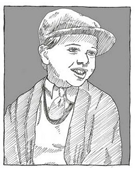 |
March 24, 2006 Ten Sides to Every Blog It's often said that there are two sides to every story. Ten-sided stories are a bit rarer and are usually the subject of great mysteries. Francis Hwang's Ten-Sided blog art project doesn't stray far from this norm. In this case, the real mystery is how the nine writers with whom he's collaborating will manage to tie their disparate narratives together over a three-month period, beginning this week. Commissioned by Turbulence.org, the blog channels the pseudonymous voices of Hwang, Johannes Gorannson, Jess Kilby, Tao Lin, Brendon Lloyd, Jessica Penrose, Glenis Stott, John Woods, Taren McCallan-Moore, and Why The Lucky Stiff, each of whom writes as a character that they are required to connect to the other characters, relying only on the information in their public posts. Hwang calls Ten-Sided a 'textual performance' and compares it to a jazz session or a game of exquisite corpse. With so many cooks in the kitchen, the potential for an exquisite mess seems delightfully high. In the mean time, readers can dive into the first-person adventures of these sundry personae. Things are just beginning to heat up. - Marisa Olson |
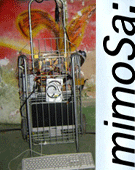 | February
10, 2006 Media Revolution Having survived colonisation, dictatorships, and inflation of 2639%, Brazil entered the 21st century with nearly half of its population living in extreme poverty and its media tightly controlled by Rede Globo, one of the biggest conglomerates in the world. Enter mimoSa--an 'urban intervention and information correctional machine'--inspired by the belief that a new system of public broadcast is a means to achieve better distribution of power, representation, and visibility. Employing free and open source software, the machine facilitates the recording, uploading, and transmission of public stories. 'mimoSa' is now travelling throughout Brazil holding workshops at which people can build their own machine and take control of their own media. Telephone numbers and instructions are also painted on city walls and streets so that anyone can participate via their mobile phone. Created by Brazilian activists midiatactica.org, Canadian group Murmur, and individual artists and programmers, 'mimoSa' was commissioned by Turbulence.org in October 2005. Look out, Rede Globo! - Helen Varley Jamieson. http://turbulence.org/works/mimoSa/ |
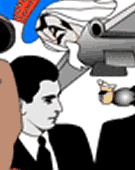 |
December 7, 2005 The Other Middle America Looking at a map, Central America
appears as a link connecting the massive North and South American continents.
Sandwiched between Honduras and Costa Rica, at the center of this connective tissue,
is Nicaragua. Like many places situated between such large and often opposing
forces, its history contains many narratives of conflict and migration. To investigate
these contentious histories, New Jersey-based artist Ricardo Miranda Zúñiga
has created Fallout, a project that uses the web to redirect the grand
narratives of Nicaragua through the identities of historical figures and the site's
visitors. Personal recollections augment, disrupt, and coexist with stories of
socialist revolutions and US interventions. The internet-based work will also
inform a new installation by the artist at Momenta Art, in Brooklyn, from 9 December
through 23 January. The physical manifestation of the project, titled 'Fallout:
What's Left,' will feature specially-commissioned propaganda posters, a new video
game, a mini FM radio station, and free voice-over-internet phone calls for migrants
separated from their families during the holidays. Viva la historias colectivas!
- Ryan Griffis |
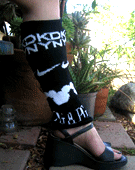 | August
31, 2005 Get Your Knit On! Last
week, I used knitPro to knit an anarchy symbol on a cardigan for my neighbour's
new baby! All creative knitters should be familiar with this very handy tool created
by microRevolt, with which users can upload images and download a pattern.
But knitPro isn't just about helping out crafty folk. microRevolt's mission
is to "investigate the dawn of sweatshops in early industrial capitalism
to inform the current crisis of global expansion and the feminization of labor."
Founder Cat Mazza's efforts will be acknowledged by a well-deserved Honorary Mention
in the Digital Communities category at this year's Ars Electronica Festival, opening
tomorrow. The Logoknitting tactic promoted by microRevolt involves placing
logos of well-known corporate sweatshop offenders, such as the Gap and Nike, into
DIY fashion items. This ironic act of resistance counteracts corporate disregard
for the work and skill that goes into mass-produced clothing. microRevolt
provides basic knitting instructions, information about protest activities, such
as the Nike Blanket Petition, and excellent links to anti-sweatshop organisations
and knitting sites. Grab your needles and stitch together your own connections
between advertising, labour, production, and consumption in the global economy.
Then stage your own knit-in. - Helen Varley Jamieson. |
 | July
29, 2005 Telling Tales 7am:
my alarm forces me out of bed on a dark winter's morning. Across the globe, the
summer sun is setting on Paris and Barbara Campbell is about to deliver episode
31 of 1001 Nights Cast, a durational webcast performance inspired by Sheherezade's
legendary survival strategy. Each day, Campbell selects words from Middle East
news reports, renders them in water colour and posts the resulting image online
as a writing prompt to visitors. She then selects and adapts one or several of
these stories for that evening's performance script. Previous episodes are archived
on the site and reflect diverse origins, themes and characters. The performance
I witnessed stemmed from "focus of all lenses." The story interweaves
a Western schoolboy's teenage dilemmas with a glimpse of homoeroticism amid the
turmoil of another bombing: human tenderness against a backdrop of violence. These
are real people we're talking about. The webcam shows a close-up of Campbell's
mouth as she calmly reads the story. A human mouth from which issues forth a story.
I am drawn into another life, other experiences. 970 to go, and then, still, all
the stories will not have been told. - Helen Varley Jamieson. |
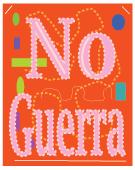 | July
6, 2005 Public Poster Production Imprimatur,
a multi-user software for poster-making, is the latest online tool for collaboration
from artist Andy Deck. The software brings the design process to life, allowing
multiple designers to team to democratically tweak the layout and statements of
a single canvas. Anyone with a smidgeon of graphics experience will find the interface
easy to use, and the product is a PDF that can be disseminated widely via email
and print. In his background to the work, Deck refers to the proliferation of
homemade posters in the aftermath of 9/11 and at the invasion of Iraq. He envisages
"a wave of colorful, independent, and low-budget posters in public places"
and sees Imprimatur as a means to channel energy into thoughtful public
dialogue. Like many of his previous works, Imprimatur is written in Java,
but this time the source code is not quite open; as a challenge to funders to
support software art, Deck will only release the source code once he has received
his next commission (New Radio and Performing Arts funded this one). I hope he's
made a poster about that. - Helen Varley Jamieson |
 | May
2, 2005 Just Obey Your Ads The
chipper, poignant and irksome imperatives launched from all corners of daily routine
by competing companies permeate our commutes, grocery lists, and vernaculars.
Current mantras like 'Laugh More. Cry More. Experience More.' (Blockbuster), 'Try
Being More Of A Woman!' (Coty Perfume) and 'Get the Most Incredible Memory Ever.'
(Dell) make big demands or promises to their targets! The Institute for Infinitely
Small Things, based in and out of Boston, endeavors to compile authoritative research
on this topic, comprising a project called The International Database of Corporate
Commands. In the opinion that these commands function within society and public
consciousness on a nano level that is virtual and powerful, the white-lab-coated
Institute invites researchers from all over the world to upload documentation
of corporate commands to their online database. By gathering them all in one place
and enacting certain slogans in real spaces--a recent flash-mob-meets-teach-in
'microperformance' at a Cingular store produced 10 minutes of literal 'Roll(ing)over'--the
institute hopes to produce a better understanding of the ramifications of constant
commercial programming. If you'll be in Boston, come visit the Institute on Saturday
and Sunday afternoons (2PM) at Space 200 (200 State Street). - Kevin McGarry |
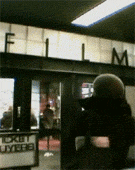 |
March 25, 2005 Pop Ups Are The New Wave Life, for Jean-Luc Godard's 'children of Marx and coca-cola,' was an extended meditation on politics, pop culture and the vicissitudes of dating. Peter Horvath adapts the concerns of this generation and the filmic style in which they were rendered in his new work of net cinema Tenderly Yours. Here, the story of Josephine--a contemporary French woman who 'detests money/ thinks herself a marxist/ and thinks she is too old for her age'--unfolds in two simultaneous Quicktime videos. The central window illustrates her brief encounter with a like-minded young man while the smaller, peripheral frame provides ambient and intimate asides in the form of colorful abstractions and pixilated close-ups. Nodding both to the early writings found in the journal Cahiers du Cinema and Lev Manovich's more recent Soft Cinema, Tenderly Yours exploits net conventions to emulate the spontaneous, fragmented and naturalistic mode of new wave filmmaking. The question is whether the quandaries of the children of Marx and coca-cola are relevant to the kids these days, or if perhaps the generation to which Josephine belongs should claim new lineage. - Lauren Cornell |
 |
March 2, 2005 Pod Pals From the busy, lonely halls of post-Valentine's Day winter comes a project about 'two people in two places living together while apart.' IN Network is a collaboration between bi-coastal conceptual sweethearts Michael Mandiberg (New York) and Julia Steinmetz (Los Angeles). Presently unable to live in the same city, they opt to occupy the same routines, which they synchronize and electronically relay to each other through sets of camera phones and microphones. Powered by a phone promotion that allows for unlimited airtime between clients who are 'in network,' Mandiberg and Steinmetz are in touch 24/7. During the month of March, Turbulence.org will host webcasts, podcasts (audio broadcasts distributed to hardware via software subscription), and a moblog (blog of mobile phone photography) to transmit to an online audience the constant correspondence that describes their fused existence: 'driving to/from work, eating dinner, giving lectures to students, going for walks, having cocktails, reading books in silence, falling asleep and waking up.' This sharing of lives, though consisting of the mediatized and mundane, is less entrenched in data and detritus than it is in the lives of, and new possibilities for being, people. - Kevin McGarry |
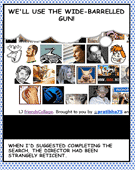 | February
22, 2005 Comix for Jung Ones Kate Armstrong and Michael Tippett are exploring where and how narratives might emerge from a collaborative environment whose participants are thrown together in a dynamic mix. In Grafik Dynamo, these artists are packaging a LiveJournal feed--news and images from the real-time blogosphere--into Lichtensteinian frames. In short: a random re-blog comic strip. The initial idea was to pull from RSS feeds being created on servers all over the world; so as an ever-increasing number of blogs are parading pop culture, news, art, politics, science, personal rants, etc., Grafik Dynamo would make an exquisite corpse of this collective conscious. Comics have become an experimental form that routinely reaches into surreal, photorealistic, and impressionistic realms. The juxtaposition of these varying styles, speaking back to broad trends across blogging culture in this format, is uncanny in the Freudian sense: strange but familiar... I think I've read this comic before... And the layout? Armstrong and Tippet ironically display the new religion of information as a continually regenerating triptych, begging questions of author-ity, narrativity and 'public' information in general. - Nathaniel Stern |
 |
February 7, 2005 You've Got to Getaway! Nathaniel Stern and Marcus Neustetter are getting their hands dirty along with a team of local Johannesburg programmers and sign-makers to stylistically markup the five websites targeted by their ongoing getawayexperiment.net, a recent turbulence.org commission. Viewed through the getaway site, graphics occurring on fox news, google images, joburg.org.za, solidarity and turbulence are postered over by handmade alternatives: scanned sketches, watercolors, and paintings depicting their digital originals. The information-heavy sites' texts and layouts are left intact; only the markers around them have been given paint jobs. Does this look like analog web design or its full-circle opposite? Regardless, completing the replacement, or helping it tread water, while, say, the google gif engine steams away, is a Sisyphisian objective that implores the participation of collaborators near and far. Login to getawayexperiment.net's edit mode to upload your own restyled signs. - Kevin McGarry |
 |
November
15, 2004 31536000 Seconds Of Fame Visitors to the web-based project 1 Year Performance Video are invited to log in and view Mark Rivers and T. Whid living out 365 days within the confines of identical, sparsely furnished, white rooms. The latest in their series of 'Updates' on seminal performance art from the 60's and 70's, this piece follows from Sam Hsieh's notorious 'One Year Performance 1978-79' in which the artist isolated himself in a cage-like room for a year's time. In MTAA's version, the test of endurance is shifted onto the viewer as the artists have replaced the human labor involved in the original performance with 160 pre-taped clips that run continuously -- and according to the clock -- for the course of a year. If the viewer successfully finishes the piece, they can redeem their time by gaining ownership of the two XML files of the artists, i.e. becoming the collector of a unique set of art data. Consider exchanging your downtime for higher status by dropping in on MTAA. And on your way, perhaps lend some support to turbulence.org who consistently perform real labor to make provocative projects like this one possible. - Lauren Cornell |
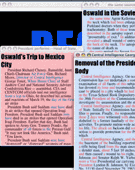 |
October
7, 2004 Julia Kristeva's notion of intertextuality looks at the complex ways in which a given text is related to other texts. She claimed that every document is, in some way, a mosaic of other texts; every text is an absorption and transformation of others. Regime Change, the first of two, turbulence commissioned, textual instruments by Noah Wardrip-Fruin, Brion Moss, David Durand, and Elaine Froehlich, literalizes and plays on Kristeva's connections. Beginning with a news article excerpt on Iraq, from April 2003, participants hyperlink between short passages from the Warren Commission, and back again. Viewers-turned-performers then jump between layers, and can add text back into the pieces preceding them. Eventually, the generated, mosaic texts become familiar committee-speak, requiring only contemporary names for us to read them as any contemporary subject: the 9-11 commission, Osama = Saddam, Swift Boat Veterans for Truth... And one bonus for dedicated players: with enough interaction, Regime Change's behavior shifts slightly, allowing your intertext re-mix to include a bit of the unexpected in uncanny ways. - Nathaniel Stern |
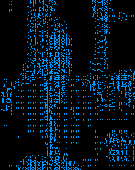 |
September 29, 2004 ASCII, like fire, purifies. At least that's what New York artist Yoshi Sodeoka of group C505 hopes. Watching this latest project, ASCII BUSH, currently spotlighted at turbulence.org, one can see the similarities between the element and the protocol governing character interchange: alphanumerics twist through footage of two State of the Union addresses like tongues of flames. Sodeoka has filtered video from two generations of Bush presidents, offering online two lengthy addresses (January 12, 2003, by the incumbent George W. Bush; and March 6, 1991, by his father George H.W. Bush) rendered entirely in ASCII characters. The audio evokes a synthetic ambience, while numbers and letters pulse and converge, stitching together these presidential talking heads. According to the project notes, Sodeoka aspires '...to make art from the debris of our culture by recycling these dreadful and painfully long presidential oration(s)'. Quite possibly, these ASCII movies are closer to the true state of the union than the propaganda offered in the source materials. - Lewis LaCook |
 |
September 8, 2004 Key Strokes for Turbulence Richard Nixon once explained: 'The Chinese use two brush strokes to write the word 'crisis.' One brush stroke stands for danger; the other for opportunity.' Such Chinese 'crisis' understands the Roman 'Janus' understands the Modern ambiguity. And all understand the strengths of the turbulence blog - a blog which embraces both the turbulence and brainstorms of conversation. By showcasing network-enabled performances, and initiating dialogs about them, turbulence.org has established a collective planning team for its Spring/Summer 2006 conference. Organized by artists Helen Thorington, Michelle Riel, Jo-Anne Green, John (Craig) Freeman, Brooke Knight, and a squad of guest-bloggers (currently Nathaniel Stern), and supported by New Radio and Performing Arts, Inc. (NRPA), turbulence.org/blog houses an exciting array of international networked performance. Recent posts include political word play, helium balloon soundscapes, and responsive architectures. And while comments are still picking up steam, the scope and creativities of the posted performances promise for a conference full of opportunity (and maybe some danger). - Alyssa Wright |
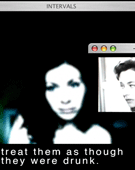 |
August 11, 2004 In her 1924 paper, 'Mr Bennet and Mrs Brown,' Virginia Woolf proclaimed that in order for a novel to be interesting, it must express its characters. It must stray from the British, 'clumsy, verbose and undramatic' form that had evolved up until the turn of the century. Fiction, she argued, had shifted from thematic to formal. I believe that Woolf's mantras are beautifully, but subtly, embodied in Peter Horvath's latest work, Intervals, commissioned by turbulence.org. The network is used as a portal into this net.art piece, where there's no questioning his unique and provocative use of the browser as a cinematic tool for character-based vignettes. Windows as prosceniums, curtains and keyholes paint pictures of uncanny personalities, asking us to re-member alongside a narrative that may or may not be at the tip of our own tongues. - nathaniel stern |
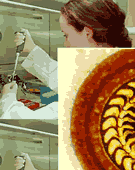 |
July 26, 2004 Hereditary Remix DNA has become as powerful a force in popular culture as it is in the sciences, for better or worse. Some may go so far as to say that the power attributed to the double helix in the social imaginary is unrepresentative of current scientific positions. Whether or not one sees the 'Genetic Revolution' as a real worldview shift, it would be difficult to find many aspects of daily life that have not been touched in some way. The interactions between pop culture, public policy, and the industrial management of genomic research are the subject of Memory Flesh 2.0, a new project by artist Diane Ludin commissioned by New Radio and Performing Arts. The second in a series of works by Ludin to explore the place of genomics in the popular imagination, Memory Flesh 2.0 juxtaposes images and text from the ongoing narrative of the genomic project, sound bites from public officials, and video of a live performance of the artist seemingly stitching different parts of her body. With recent events in the US involving artists and biotechnology, it's not hard to see how genetic policy can impact a body without manipulating even one gene. - Ryan Griffis |
 |
May 3, 2004 Don't Touch That Dial! Surveillance culture isn't a new thing really. Remember the Cold War - nuclear proliferation, international espionage, all that? Well now you can experience all those feelings of alienation and paranoia but with a new media twist. Brought to you by Turbulence.org, founding member of New York based C505 Yoshi Sodeoka's Prototype #44, Net Pirate Number Station takes you back to the Cold War era when shortwave radio anticipated the internet's capacity for anonymous, surreptitious worldwide communication. The 'numbers stations,' it is believed, were used by military powers to broadcast coded number sequences to spies in the field. Delivered in a repetitive monotone, usually by a female voice, the eerie transmissions developed a cult following and infiltrated the arts through jazz and electronic music. Sodeoka's project uses the numbers stations as a model for a tongue-in-cheek, James Bond Meets Kazaa critique of new art culture itself, in which text "pirated" from websites is converted into numbers and delivered to visitors by three prerecorded video host personalities. Cold, detached, and just boring enough to be interesting, this station might be the new big thing. - Peggy MacKinnon |
 |
April 9, 2004 Stormy Weather You've heard of 'sex haze' this is 'media haze', a kind of fog created by the constant barrage of sound, image, and text that surrounds and defines current events. For his new project, <event>, American artist Michael Takeo Magruder has parsed recent BBC broadcasts and layered the audio, video and text related to each news item. Multiple perspectives should provide clarity- instead they obscure, producing a cloud of media static. We pick up only the most basic buzz words, the outlines of shadowy forms. Magruder's project is not fun to look at; he excels at creating just that feeling of helplessness in the face of too much information. This feels more like a primitive IQ test than a new media project - if so, we are all failing miserably. - Elizabeth Bard |
 |
February 9, 2004 Swipe It. Swipe It Good The collection of personal data has certainly become a more visible process in post-Patriot Act U.S.A, both for American residents and visitors. And it's no consolation to know that for every visible act of fingerprinting, there are even more instances of invisible archiving going on. 'Swipe,' an ongoing project by new media artists/engineers Beatriz da Costa, Jamie Schulte, and Brooke Singer documents the process of personal data collection in the U.S., shedding some light on these hidden databases. The collaborative has released a new element of the project, an online 'toolkit,' featured on New Radio and Performing Art's Turbulence web portal. Swipe's toolkit includes such handy items as a calculator for determining the value of your personal data, forms for requesting a copy of the data that private companies have collected on you, and a bar-code reader that can decipher those printed codes on the back of many U.S. driver's licenses. The project also takes the form of live performances that include a cocktail bar... because you may need a drink when you find out what 'they' know about you. - Ryan Griffis |
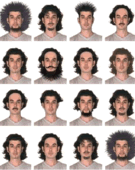 |
December 29, 2003 Better than Santa Claus Turbulence.org is currently showcasing recent work by French artist Nicolas Clauss, the creator of the bilingual art site flyingpuppet.com. In eight interactive web pieces made over the last 18 months, Clauss has further developed his signature whimsical style. Subtle interactive components enhance a collage of audio fragments and dream-like images, resulting in mesmerising performative etudes. Influenced by contemporary dance as well as his original medium, painting, Clauss aims to express a depth of feeling beyond genres, words and concepts. The works cover a range of themes, from the esoteric to the humorous (run your mouse over the portraits beside the artist's bio for a smile). In fact, run your mouse over all of Clauss' work and you'll find gifts to rival what the other Claus might have left under the Christmas tree. - Helen Varley Jamieson |
 |
May 6, 2003 Brat Packets The genealogy connecting Net.Artists to Duchamp, as claimed by Vuc Cosic, may be inflated to some, but the originator of the readymade makes a versatile springboard for many art discussions. Duchamp's Ideal Children's Children: Net Art's Brat Pack is a curatorial project of artist Eryk Salvaggio that re-presents the works of four other artists all under the age of 25. Interviews conducted with the artists - Cory Arcangel, Geoff Lillemon, Kalx and Michael Mandiberg - provide opportunities to read about the various influences and histories that inform their work. And as one would expect from descendants of Duchamp, they neither refute nor confirm any family ties. - Ryan Griffis |
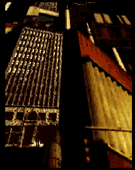 |
April 17, 2003 Studio Visit with Peter Horvath Turbulence Artist Studios recently launched some works by Peter Horvath as part of its program to showcase fresh faces in the net.art scene. Featuring 3 full-length and 6 ten-second web pieces, Horvath's works are non-interactive, net.based videos engaging us in the possibility of technological intimacy. They are multilayered and created with a logic and aesthetic endemic of the web, while referencing surrealist and collage film vocabularies. These works employ the lyrical language of the cinema to compose an autobiographical portrait wherein the viewer hovers over a series of multi-layered videos. Finally, they exist as a composition of emerging frames which overlap, collapse and fill the computer?s own bordered space. - Valerie Lamontagne |
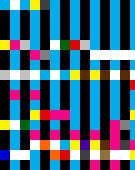 |
March 5, 2003 11 Hours of Hot Uncensored Raw Data From Moebius's art deco sets in 'Tron' to William Gibson's 3D datascapes in 'Neuromancer', many artists have imagined what it might look like inside the machine. Cory Arcangel bypasses such stylized, anthropomorphic visions and simply shows us his raw data, 11 hours worth, in all its glitchy 8-bit nakedness. Arcangel tricked Quicktime into reading the binary data daily passing through his computer's RAM. The result is Data Diaries, a collection of intriguing, abstract data 'movies' (complete with audible bleeps and squawks), available in color or black & white. Pass the pixelated popcorn! - Curt Cloninger |
 |
January 29, 2003 Sequencing the City Before there was Flash animation, there was the subway. Graffiti-covered trains are a distant prototype of digital motion graphics, animating colorful designs and text against a sliding urban backdrop. In his new Stop Motion Studies series, David Crawford returns to the subway car as vehicle of expression, manipulating its interior time and space rather than its exterior surfaces. The result is an urban character study befitting our age of digital compression. Passenger emotions -- exhaustion, boredom, happiness -- are pared down to their most essential keyframes and played back in infinite, asymmetrical loops. Though motion is limited to a few degrees in Crawford?s ticking snapshots, these subtle, personal moments are indeed moving. - Matthew Hutchinson |
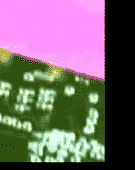 |
January 17, 2003 Murthy-Haraway-Hybrids Using the format of search engine results, Prema Murthy's Mythic Hybrid presents contextual information on a group of women in India, micro-electronics factory workers who reported having collective hallucinations. These women are the artist's focusing device as she remodels information on industrial conditions, spiritual phenomena and womens' status. The associations Murthy brings together are varied, but make conceptual sense not just in light of the fascinating story about the hallucinating workers, but also in tandem with some of the radical notions about women and the real in Donna Haraway's Cyborg Manifesto -- a book that informed this project. - Rachel Greene |
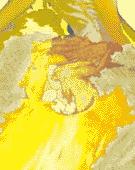 |
November 28, 2002 Kanarinka Can Kanarinka is the only net artist I can think of who does color studies. Her work on yellow, 'Color Stories - Yellow' integrates samples featuring the color to build 'art modules.' Some of these have an informal quality, but still, perhaps because of the affective capabilities of the color, they seem to move beyond the screen. In other modules, the dominance of color gives way to a focus on narrative, or to an investigation of animating color. Some 'Stories' seem in line with Abstract Expressionist concerns with 'beauty;' others evoke color field studies. There is a lot here -- Kanarinka's work covers some dense (yellow) territory. - Rachel Greene |
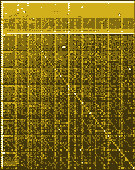 |
June 19, 2002 It All Adds Up What is the most popular number on the Net? Surely '69' is making the rounds, and we'd all like to see a little less of '404' (the number associated with 'File Not Found' errors)? Contributing to the growing pool of data-visualization oriented work are artists Golan Levin, Jonathan Feinberg, Martin Wattenberg, and Shelly Wynecoop. Their project, The Secret Lives of Numbers, is the beautiful result of an exhaustive study to determine the relative popularity of every integer between zero and one million, on the web. Log on to contemplate the various social patterns of numeric codification. Or just check out how your lucky number stacks up. |
 |
February 14, 2002 Numbers are Cool at Turbulence.org How often do you visit Turbulence.org? If not too often, now would be a good time. Recently, the New York new media organization launched "The Secret Life of Numbers" by Golan Levin with assistance from Martin Wattenberg, Jonathan Feinberg, David Becker, David Elashoff and Shelley Wynecoop. Fun for math geeks everywhere, The Secret Life of Numbers is about the popularity of numerals. Using custom software, popular search engines and statistical tools, the artists surveyed the public to understand what integers were the most favored, as if members of a boy band. Rather than just present cold statistics, though, the artists give site visitors an interactive visualization. Who said numbers weren't cool? |
 |
July 11, 2001 The Shape of Song For some synesthesia in action, look no further than Martin Wattenberg's latest project, The Shape of Song -- which just made its debut online at turbulence.org. Wattenberg attempts to visualize various kinds of music via customized software that translates any composition available on the Web into elegant arch-like images and curvy forms. |